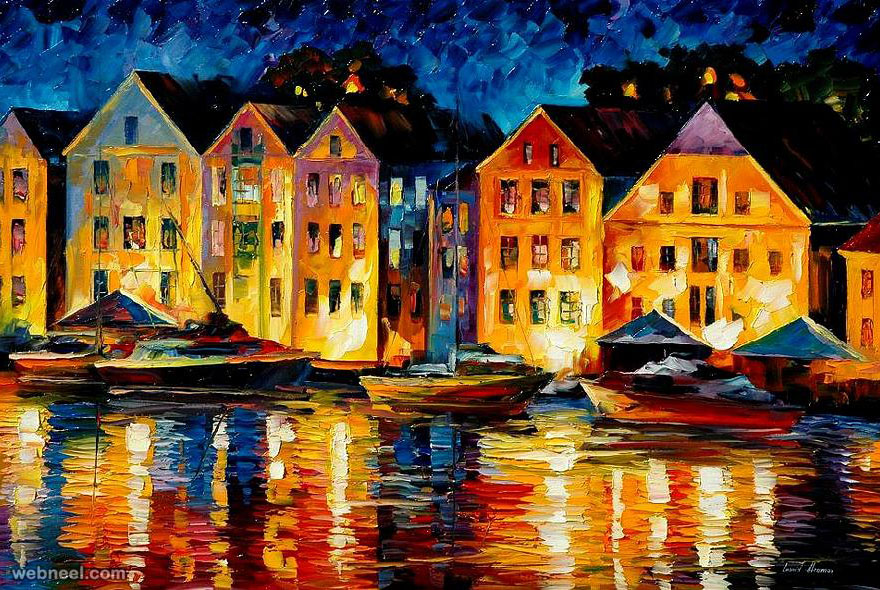What to Think about in Selecting the Perfect Oil Paintings for Your Home Decoration

Recognizing Your Individual Style
Understanding one's personal style is necessary when picking oil paints for home design. People must first mirror on their preferences, taking into consideration aspects such as color, motif, and emotional vibration. Some may move in the direction of lively abstract items that stimulate energy, while others may choose peaceful landscapes that advertise harmony. Recognizing whether one leans towards modern-day minimalism or standard realistic look can assist the choice procedure. In addition, personal style commonly mirrors social influences, experiences, and artistic preferences, making it vital to pick items that resonate deeply. By straightening their options with their unique visual, people produce a cohesive atmosphere that boosts their space, inevitably resulting in a home that personifies their personality and worths via art.
Thinking about the Dimension and Range
Dimension and range play a crucial duty in the effective combination of oil paintings into home decor. Picking the right measurements warranties that artworks enhance the room instead than bewilder or underwhelm it (oil paintings for sale). For larger rooms, considerable paints can work as prime focus, including depth and passion. Conversely, smaller artworks can enhance comfortable areas without triggering clutter. It is vital to think about wall room and furnishings setup when choosing dimensions; a well-placed paint can produce consistency and equilibrium in an area. In addition, organizing smaller sized items can produce a cohesive gallery result, while a solitary large canvas may stand alone as a declaration item. Eventually, the chosen size and scale must show the overall layout intent of the home
Choosing the Right Color Scheme
Choosing the appropriate shade scheme for oil paints is essential to improve a home's decor. It not only enhances existing furnishings however also sets the wanted state of mind for each and every room. Furthermore, the effects of lighting can substantially affect just how colors are perceived, making careful consideration trick.
Enhance Existing Decoration
An unified color scheme can transform a room, making oil paintings an excellent selection for improving home style. When choosing artwork, it is important to ponder the existing colors in the space. A paint that complements or contrasts the dominant hues can produce aesthetic interest. If a room features soft blues and whites, an oil paint with similar tones can combine the style, while a vibrant, different item can offer as a focal point. In addition, comprehending the touches in the room's color design-- whether trendy or cozy-- can assist the option of art work. Eventually, the ideal oil paint ought to enhance the overall visual, producing a natural and inviting environment that shows the homeowner's personal design.
Establish the State of mind
Choosing the right color combination for oil paintings can greatly influence the state of mind of an area. Warm colors, such as reds and oranges, often tend to develop a welcoming and energised atmosphere, making them perfect for social areas like living rooms. On the other hand, trendy tones, such as greens and blues, promote peace and leisure, perfect for bed rooms or checking out spaces. Neutral shades, including grays and browns, can provide an innovative backdrop, permitting other aspects to shine. In addition, thinking about the emotional influence of certain shades is vital; for example, yellow can evoke joy, while darker shades can infuse a sense of drama. Inevitably, picking a shade scheme that straightens with the desired ambiance will certainly improve the total decor and individual expression within the home.
Consider Lighting Results
The impact of lights on the assumption of oil paintings can not be ignored when curating a home style plan. All-natural light, as an example, can drastically change the hues and structures of an art work, improving its vibrancy or silencing its tones. On the other hand, synthetic lights can develop shadows or highlights that may either enhance or take away from the painting's general impact. Therefore, home owners must consider the strength and type of light in a room when picking oil paintings. Warm illumination can improve natural shade combinations, while cooler lighting may suit a lot more vibrant, contemporary art. Inevitably, recognizing just how various lighting affects color perception is crucial in selecting the best oil paints that harmonize with a space's setting and aesthetic objectives.
Selecting a Theme or Subject
When picking a motif or topic for oil paints, individual design choices play an important function in making sure that the art work resonates with the home owner. Furthermore, taking into consideration the performance of each area can direct choices that improve the overall ambiance. Preserving harmony with the existing shade combination is essential for creating a cohesive and inviting room.
Personal Design Choice
Personal design choice plays an important duty in picking oil paintings that boost home decoration. Individuals often incline specific styles or topics that resonate with their preferences and individualities. A person with a penchant for nature might prefer landscapes, while someone attracted to urban life could select cityscapes. Abstract art can appeal to those that value contemporary appearances, while classic still lifes may draw in traditionalists. The chosen artwork ought to reflect the home owner's identification, producing a cohesive environment. In addition, color pattern and emotional tones of the paints can significantly impact the room, contributing to a preferred ambiance. Ultimately, straightening the artwork with individual style choices click here assures that the chosen oil paints act as meaningful prime focus in the home.
Space Performance Consideration
Just how can room capability influence the selection of oil paintings? The purpose of a room plays a vital role in establishing the suitable theme or subject for oil paintings. In a tranquil room, calming landscapes or abstract items can evoke tranquility and relaxation. Conversely, in a vibrant living area, dynamic and lively art work might boost the energised environment. Dining locations can take advantage of still-life or food-related paintings, which can boost discussion and hunger. Additionally, the option of artwork ought to line up with the activities taking place in the area; as an example, inspirational pieces in an office can motivate performance. Eventually, selecting paints that resonate with the room's function assures an unified and welcoming environment.
Color Palette Harmony
A natural color scheme is necessary for selecting oil paints that improve the total design of a home. When choosing artwork, people ought to consider the existing colors within the room, including wall tones, furniture, and accessories. Paints that enhance or comparison sympathetically with these components can raise the visual allure of a space. In addition, choosing a theme or subject that reverberates with the property owner's individual design develops a much more inviting ambience. Tranquil landscapes could match a relaxing resort, while vivid abstracts could invigorate a dynamic gathering area. Eventually, the best combination of shade and motif guarantees that the art work not just fits within the design but likewise adds to an unified and expressive home setting.
Assessing the Psychological Effect
What feelings do certain oil paints evoke in an audience's area? The emotional influence of an artwork can considerably affect the atmosphere of a room. Vibrant shades and dynamic brush strokes may inspire power and creative thinking, while softer hues and serene landscapes can stimulate tranquility and peace. Abstract pieces frequently motivate introspection, welcoming audiences to analyze the emotions shared. In addition, the topic plays a vital function; pictures can instill link, while nature scenes may promote a sense of peace. Audiences might likewise locate fond memories in art work that mirrors personal experiences or memories. Inevitably, picking oil paintings that reverberate mentally can change a living setting, developing a room that feels genuine and welcoming to its inhabitants.
Finding the Perfect Positioning
Where in a home can oil paints best improve the general visual? Positioning is significant for making best use of the effect of oil paints. In living areas, huge pieces can work as prime focus above fire places or couches, drawing attention and triggering discussion. Entryways and corridors benefit from smaller, grouped works, developing an inviting environment. In rooms, softer, serene landscapes or abstracts can promote relaxation when hung over the bed. Eating areas can feature vibrant pieces that boost cravings and discussion. It is very important to consider lighting; natural light can change the painting's appearance, so position art work where they receive proper lighting. Ultimately, thoughtful placement can raise the state of mind and cohesiveness of a room, making the art work a fundamental part of the home's decor.
Budgeting for Your Artwork
Establishing a budget plan for artwork is important for any individual aiming to boost their home design. It assists to specify monetary boundaries, guaranteeing that the selection procedure stays enjoyable and functional. Possible buyers should consider their total costs capability, including costs for framing, installment, and upkeep. Investigating different cost varieties for oil paints can likewise offer valuable understandings right into what to anticipate. Furthermore, individuals may wish to prioritize their choices, whether they are drawn to arising musicians or established names, as this will significantly influence pricing. By establishing a clear budget plan, art fanatics can concentrate on finding items that not just reverberate with their visual but likewise line up with their monetary objectives, leading to a fulfilling acquisition experience.
Frequently Asked Questions
How Do I Keep and Treatment for Oil Paintings?
Caring and preserving for oil paintings involves maintaining them in a steady environment, preventing direct sunshine, dusting delicately with a soft towel, and periodically consulting a specialist conservator for cleaning or repair requirements.
Can Oil Paintings Be Hung in Humid Areas?
Oil paintings can be hung in moist areas, yet care is encouraged. Excess moisture may trigger paint to weaken or canvas to warp. Appropriate air flow and climate control can assist minimize potential damage with time.
What Is the Distinction In Between Original Art and Prints?

Exactly how Do I Pick a Framework for My Oil Painting?
Selecting a frame for an oil painting includes thinking about the art work's style, shade combination, and size. A well-selected framework improves the piece, matching its visual while shielding it from damages and adding to its presentation.
Exist Details Musicians Understood for Home Design Oil Paintings?
Several musicians focus on oil paints appropriate for home design, consisting of Claude Monet for impressionistic landscapes, Gustav Klimt for decorative concepts, and Georgia O'Keeffe for vivid flower compositions, each offering one-of-a-kind designs to improve indoor rooms. Understanding one's personal style is necessary when selecting oil paints for home design. Choosing the appropriate shade combination for oil paintings is crucial to enhance a home's decor. A harmonious color combination can change a room, making oil paints an ideal selection for improving home style. Personal design choice plays an important duty in selecting oil paintings that boost home decor. A cohesive color combination is necessary for choosing oil paints that enhance the general decor of a home.